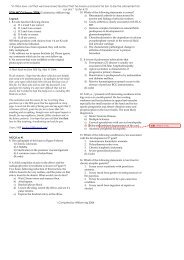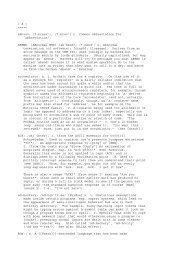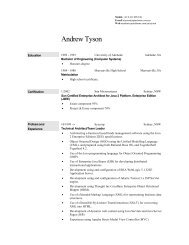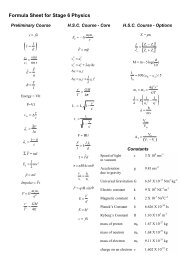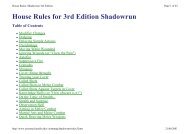Notes to Submission to the Productivity Commission Inquiry into the ...
Notes to Submission to the Productivity Commission Inquiry into the ...
Notes to Submission to the Productivity Commission Inquiry into the ...
You also want an ePaper? Increase the reach of your titles
YUMPU automatically turns print PDFs into web optimized ePapers that Google loves.
<strong>the</strong>re is no demand for access (e.g. wheelchair accessible <strong>to</strong>ilet in an spot which isinaccessible <strong>to</strong> a wheelchair user) 15 .Some unresolved questions raised by <strong>the</strong> Act and <strong>the</strong> HREOC <strong>Notes</strong> include <strong>the</strong>following.• The DDA’s use of <strong>the</strong> word “hardship” implies a threshold, below which somelevel of cost <strong>to</strong> a respondent is presumably justifiable but above which <strong>the</strong> cost ispresumably not justifiable. The word hardship is defined in <strong>the</strong> Oxford Dictionary as“extreme privation” and contrasts with a weaker concept of ‘loss’ but <strong>the</strong> Act gives noindication of where this threshold lies, and <strong>the</strong>refore makes one of <strong>the</strong> key defencesagainst <strong>the</strong> charge of discrimination vague and uncertain.Fur<strong>the</strong>rmore, while <strong>the</strong> Act is clear on <strong>the</strong> need <strong>to</strong> account for <strong>the</strong> effects oncomplainant and respondent, as well as “any persons concerned”, it gives no guidance onhow <strong>to</strong> balance <strong>the</strong>se costs and benefits or how <strong>to</strong> define “any persons”. Thus, is <strong>the</strong>impact on non-respondents and non-complainants given <strong>the</strong> same weight as <strong>the</strong> impact onrespondents and complainants? In using <strong>the</strong> stronger term “hardship” as opposed <strong>to</strong> <strong>the</strong>weaker term “loss”, does <strong>the</strong> Act suggest that <strong>the</strong> aggregate benefits <strong>to</strong> people withimpairments have greater weight than <strong>the</strong> costs born by <strong>the</strong> community as whole?• Economic analysis suggests that in <strong>the</strong> long-run <strong>the</strong> incidence of a tax depends on<strong>the</strong> degree of substitution in <strong>the</strong> demand for a good or service, <strong>the</strong> nature and structure ofcompetition in <strong>the</strong> industry, and <strong>the</strong> degree <strong>to</strong> which marginal costs increase as outputincreases. The real incidence differs from <strong>the</strong> nominal immediate incidence because <strong>the</strong>burden of <strong>the</strong> tax may be shifted fully or partly forward on<strong>to</strong> consumers or backward on<strong>to</strong>suppliers. Similarly, <strong>the</strong> cost of accommodating a complaint may be shifted forward on<strong>to</strong>consumers or backward on<strong>to</strong> property owners, co-workers, or product designers.Currently nei<strong>the</strong>r <strong>the</strong> complainant nor respondent can know <strong>the</strong> extent <strong>to</strong> which<strong>the</strong> court will or can anticipate cost-shifting. It may be that Act’s emphasis on ‘financialcircumstance’ and ‘amount of expenditure’ suggests that only immediate financialincidence is relevant and that economic cost-benefit analysis is beside <strong>the</strong> point.It is important <strong>to</strong> note that a narrow pecuniary interpretation of cost whichemphasises nominal cost narrows <strong>the</strong> scope of <strong>the</strong> DDA considerably in contrast <strong>to</strong> abroader economic cost-benefit approach.• The Act specifies <strong>the</strong> need <strong>to</strong> account for “financial circumstance” but it isunclear whe<strong>the</strong>r this refers <strong>to</strong> short-term liquid cash flow, long-term financial capacity, orsome o<strong>the</strong>r measure of cost. Thus, a respondent’s short-term liquid cash financial may bedue <strong>to</strong> temporary fac<strong>to</strong>rs such as interest rates, level of debt, capital needs, and changes inmacroeconomic conditions, etc… Such fac<strong>to</strong>rs are unrelated <strong>to</strong> long-term financialcapacity <strong>to</strong> accommodate a disability complaint, yet without clarification, a court maygive greater force <strong>to</strong> such irrelevant fac<strong>to</strong>rs than <strong>to</strong> long-term financial viability.15 Coase Theorem.29



